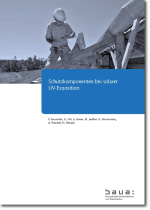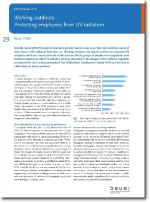Natural UV radiation puts outdoor workers at increased risk of cancer
Solar UV radiation has been classified as a Group 1 human carcinogen by the International Agency for Research on Cancer (IARC) since 2012 and is therefore similar carcinogen as asbestos or tobacco. In Germany, it causes more than 200,000 new cases of skin cancer every year. Outdoor workers are subject to an increased risk of skin cancer, although this can be effectively reduced by implementing simple measures.
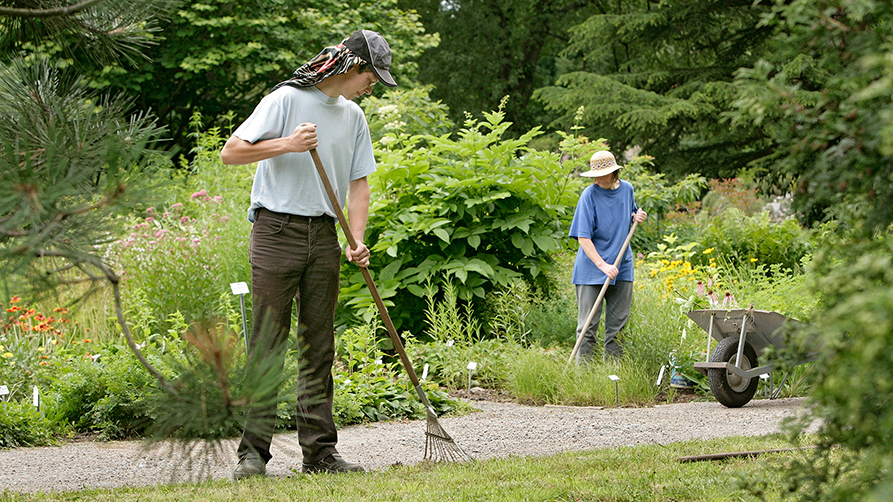
There are numerous sectors, such as the building industry, forestry and agriculture, the delivery industry, but also education and childcare, in which work frequently has to be done outside. The daily working lives of these approximately 2-7 million employees (depending on the estimate) are spent completely or partly outdoors, which means their annual exposure to solar UV radiation is markedly higher than that of the general population. However, a doubling of the cumulative UV dose leads to more than twice as great a risk of suffering from a form of non-melanoma skin cancer (i.e. there is an exponential dose-response relationship).
The legislature took this finding in 2015 into account when it added squamous cell carcinoma and multiple actinic keratoses to the Ordinance on Occupational Diseases (Berufskrankheiten-Verordnung, BKV) as occupational disease No. 5103. In addition, the Occupational Medical Rule AMR 13.3 specifies provisions of the Ordinance on Occupational Health Care (Arbeitsmedizinische Vorsorgeverordnung, ArbMedVV). It determines when outdoor activities entail intensive exposure to natural UV radiation and therefore give occasion for recommended preventive care. The Occupational Safety and Health Act (Arbeitsschutzgesetz, ArbSchG; sections 4, 5, 11, 12) and the relevant occupational safety and health ordinances, in particular the Workplaces Ordinance (Arbeitsstättenverordnung, ArbStättV; sections 3, 6, Annex 5.1), are the crucial pieces of legislation governing the protection of employees' safety and health when they work outdoors.
The UV Index as a supportive risk assessment tool
Employers have a duty to assess the risks employees face outdoors and to implement appropriate protective measures. The UV Index (UVI) can be used as a tool to support risk assessments. The index is based on erythemally relevant UV irradiance - solar radiation’s sunburning power - and is expressed on a scale from 0 to 11+.
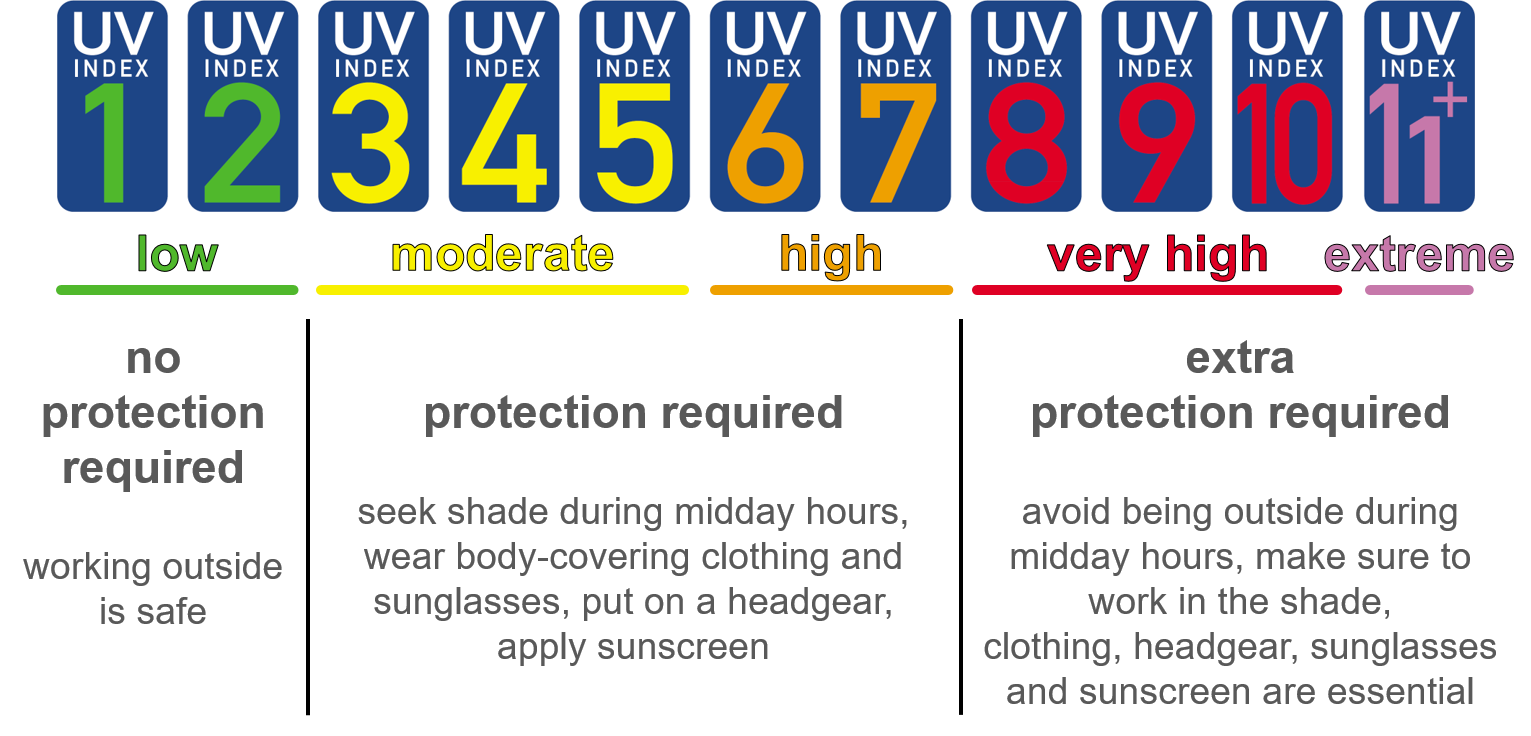
As of a UVI of 3, the World Health Organisation (WHO) recommends measures such as wearing long-sleeved tops, long trousers, and a suitable head covering and applying sunscreen to uncovered skin. Workers should stay in the shade in the middle of the day (when the sun is at its highest). These measures are absolutely vital at very high UVI levels of 8 and above. Outdoor activities should then be avoided if possible. Wearing sunglasses is always advisable.
UV Index calendar
An analysis of data from the UV measuring station at Dortmund for the years from 1998 to 2018 has been taken as the basis for the development of a simplified UVI calendar that depicts graphically the typical long-term maximum mean UVI reached each month.
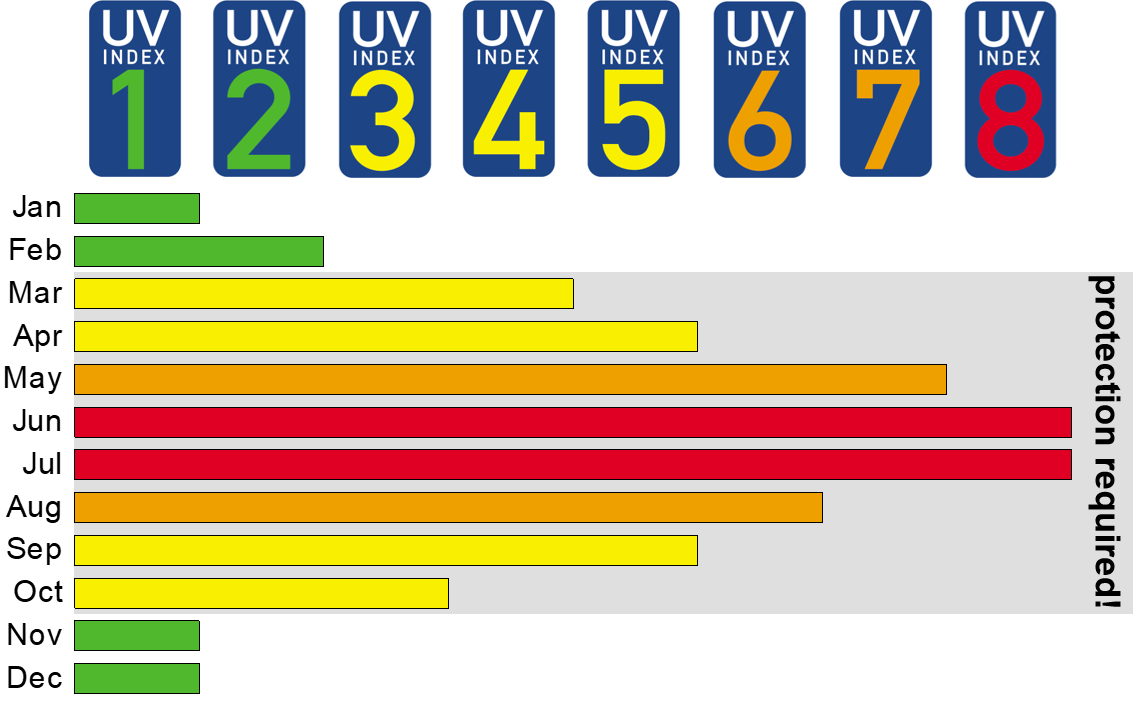
During the period covered by the analysis, for example, no UVI of 2 was ever measured in January in Dortmund, whereas this is possible on a few days in February. In June there is less than one day a month on average when the UVI goes up to 8. A UVI of 9 has not yet been recorded in Dortmund, but is possible in other parts of Germany, particularly at higher altitudes. While the UVI reaches 1 on about two-thirds of days in November, this usually only happens on approximately two days in December.
The UVI calendar is ideal for the early planning of measures relating to outdoor work that are to be implemented between March and October. However, the maximum UVI levels given in the calendar should be regarded as approximate guidelines only because lower and higher readings may be measured locally, depending on the weather conditions. In addition, unusually high UVI levels can also occur in spring as a result of what are known as "low-ozone events" in the stratosphere. In particular when temperatures rise after the winter, at a time when people start wearing lighter clothing and engaging in more open-air activities, their still completely untanned skin is put at high risk of sunburn. It is necessary to make employees aware of this issue in good time.
Given it is not possible to consult the UVI calendar constantly in day-to-day life, the rule of thumb in Germany is that the skin should be protected against solar radiation from Easter to October.
The live graph below shows how the UV Index changes in real time over the course of the day at the Federal Institute for Occupational Safety and Health (Bundesanstalt für Arbeitsschutz und Arbeitsmedizin, BAuA) offices in Dortmund. The information published on the website of the Federal Office for Radiation Protection (Bundesamt für Strahlenschutz, BfS) includes UVI levels from all over Germany.
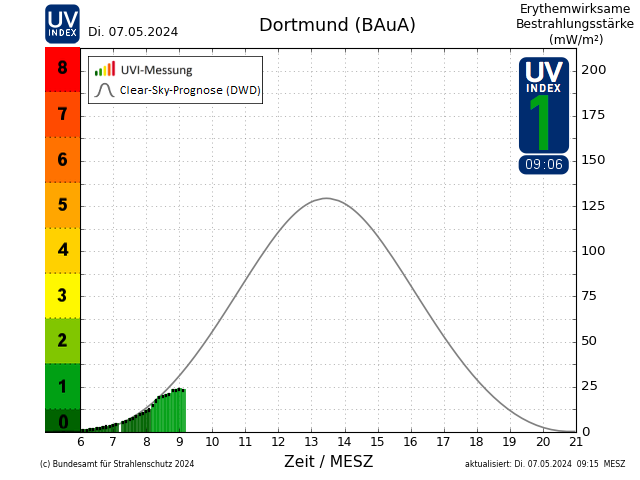
Measures
In essence, the recommendations on protection against natural UV radiation for outdoor workers are not significantly different from those intended for the general population. Technical and organisational measures have priority over personal measures, but combining them sensibly offers the most effective protection.
Technical measures
The technical measures that can be taken involve different ways of providing shade:
- Canopies, shelters, projecting roofs and sun sails/sun parasols for permanent outdoor workplaces
- Sun sails/sun parasols for mobile workplaces, with the direction the sun is coming from being checked regularly
- Side screens where there are highly reflective surfaces
- opportunities for shelter offered by buildings or plants, although the latter usually give little protection against UV radiation
- Completely enclosed cabins on mobile work equipment (with windows kept shut)
Care should be taken to ensure excessive levels of heat do not build up in workplaces when using technical measures.
Organisational measures
Organisational measures are aimed at minimising the amounts of time for which workers are exposed to the sun:
- Avoid spending time in the sun during the middle of the day (approx. 11 a.m.-3 p.m.)
- Relocate activities to shaded areas or indoor spaces
- Start work earlier or end work later (while doing the same number of hours)
- Adjust the timing of rest breaks
- Spread work between several employees
- Avoid overtime when the UV Index is high
What is more, it is of particular significance for employees to be informed about the possible risks from natural UV radiation and the measures implemented to deal with them.
Personal measures
Examples of personal measures:
- Suitable (long-sleeved) clothing that covers the body and gives adequate UV protection, for instance garments made of densely woven fabrics
- Head coverings with broad brims and flaps to protect the neck and ears
- Sunscreen products for parts of the body that cannot be protected with textiles, such as the face, the backs of the hands, and the neck (sunscreen products should have a suitable Sun Protection Factor of at least 30 and be applied correctly at regular intervals)
- UV protective goggles and sunglasses that comply with the requirements placed on sun filters for industrial use under DIN EN 172
The BAuA has been a member of the nationwide UV monitoring network since 1996 and a partner of the UV protection alliance since 2013.
